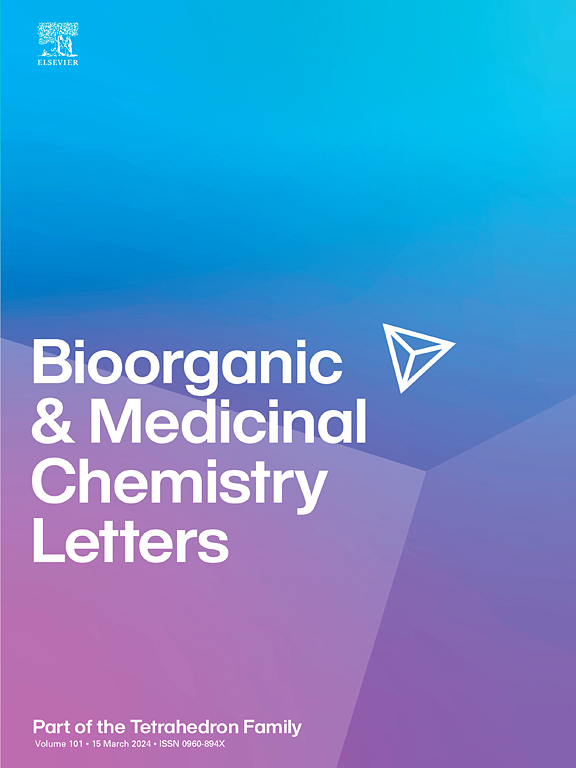Structure based design, synthesis and identification of novel covalent reversible dual TLR2/TLR9 small molecule antagonists
IF 2.5
4区 医学
Q3 CHEMISTRY, MEDICINAL
引用次数: 0
Abstract
Inflammation is a key driver of the onset and progression of neurodegenerative diseases and cancer and can be caused by aggregated proteins, injured neurons or synapses, dysregulation of inflammatory control mechanisms, and other factors. Tolllike receptors (TLRs) are important mediators of inflammatory pathways, and their activation leads to pro-inflammatory cytokine release by immune cells in the periphery or in the central nervous system (CNS). TLR2 and TLR9 are implicated in the inflammatory pathogenesis of CNS degenerative diseases such as Parkinson's Disease (PD) and amyotrophic lateral sclerosis (ALS). They are also held to be important in the etiology of certain malignancies like inflammatory pancreatic ductal adenocarcinoma and glioblastoma. Inactivation of TLR2/9 in animal models of neurodegeneration has reduced pathological markers and diminished neuronal loss, while in animal models of cancer it has suppressed tumors. Therefore, TLR2 and TLR9 may be potential targets for the treatment of neurodegenerative disorders and cancers. We identified for the first time a key binding locus in TLR2/9 TIR domain which guided reversible covalent drug (RCD) design of a novel, first-in class series of dual TLR2/9 antagonists. Sub-micromolar antagonist concentrations potently inhibited TLR2 and TLR9 signaling induced by TLR2/9 specific agonists. Importantly, this series of antagonists did not discernably activate other TLRs and exhibited favorable in-vitro ADME and safety. The analogs described here may help realize effective TLR2/9 antagonism as a viable therapeutic strategy for inflammation driven CNS diseases and various malignancies with an inflammatory etiology.

基于结构的新型共价可逆双TLR2/TLR9小分子拮抗剂的设计、合成与鉴定
炎症是神经退行性疾病和癌症发生和发展的关键驱动因素,可由聚集的蛋白质、受损的神经元或突触、炎症控制机制失调和其他因素引起。toll样受体(TLRs)是炎症通路的重要介质,其激活导致外周或中枢神经系统(CNS)免疫细胞释放促炎细胞因子。TLR2和TLR9与中枢神经系统退行性疾病如帕金森病(PD)和肌萎缩侧索硬化症(ALS)的炎症发病机制有关。它们在某些恶性肿瘤如炎性胰腺导管腺癌和胶质母细胞瘤的病因学中也很重要。在神经变性动物模型中,TLR2/9的失活降低了病理标记物,减少了神经元的损失,而在癌症动物模型中,它抑制了肿瘤。因此,TLR2和TLR9可能是治疗神经退行性疾病和癌症的潜在靶点。我们首次确定了TLR2/9 TIR结构域的一个关键结合位点,该位点指导了一类新型的双TLR2/9拮抗剂系列可逆共价药物(RCD)的设计。亚微摩尔拮抗剂浓度可有效抑制TLR2/9特异性激动剂诱导的TLR2和TLR9信号转导。重要的是,这一系列拮抗剂没有明显激活其他tlr,并表现出良好的体外ADME和安全性。本文描述的类似物可能有助于实现有效的TLR2/9拮抗剂,作为炎症驱动的中枢神经系统疾病和各种炎症性恶性肿瘤的可行治疗策略。
本文章由计算机程序翻译,如有差异,请以英文原文为准。
求助全文
约1分钟内获得全文
求助全文
来源期刊
CiteScore
5.70
自引率
3.70%
发文量
463
审稿时长
27 days
期刊介绍:
Bioorganic & Medicinal Chemistry Letters presents preliminary experimental or theoretical research results of outstanding significance and timeliness on all aspects of science at the interface of chemistry and biology and on major advances in drug design and development. The journal publishes articles in the form of communications reporting experimental or theoretical results of special interest, and strives to provide maximum dissemination to a large, international audience.

 求助内容:
求助内容: 应助结果提醒方式:
应助结果提醒方式:


